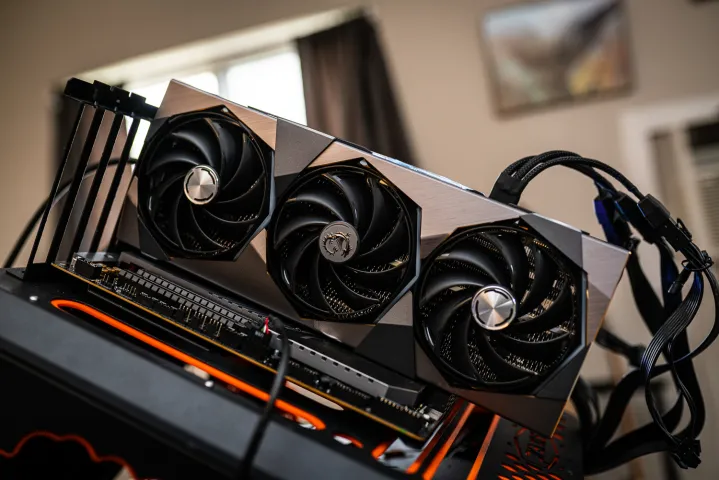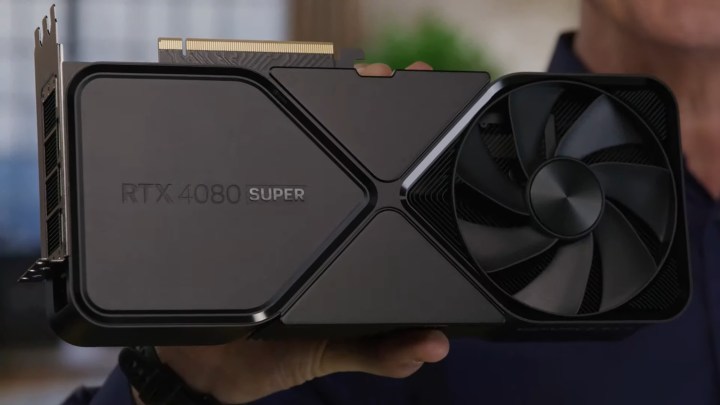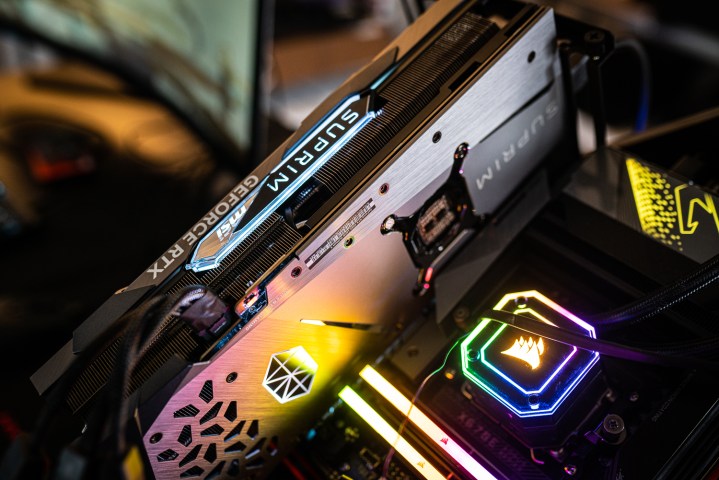
It’s me. I’m one of the people who bought one of Nvidia’s worst-value graphics cards, the RTX 4080, and now have some regrets. However, it’s got nothing to do with the performance of the GPU and everything to do with the fact that there are now better options available.
That’s not all there is to it, though. Despite meticulous planning, I didn’t account for another aspect of owning a high-end graphics card that only became clear once I used this GPU for a few months. Grab a snack, and let me take you on a journey through my GPU-related regrets.
I knew what I signed up for

Although it might seem like I didn’t do my research, and now I’m paying the price, I didn’t buy my RTX 4080 on a whim.
I spent months planning out my new PC build last year, and the GPU was the one choice I paid the most attention to. Picking a processor for a gaming build was easy, as the Ryzen 7 7800X3D is an obvious choice, but the graphics card? Choosing one turned out to be quite a headache.
I always knew that the RTX 4080 was terrible value. There’s nothing wrong with its performance — although it’s significantly slower than the RTX 4090 — but the value-for-money aspect is pretty awful; in that regard, it’s one of the worst GPUs we’ve seen in the last couple of years. Priced at $1,200 from the get-go, the GPU was only about 25% cheaper than the RTX 4090 at launch but over 30% slower. The market corrected those prices slightly over time, and at the time of my purchase, the RTX 4080 was priced at around $1,050 for the cheapest models, with overclocked cards still reaching $1,200 and beyond.
Buying the RTX 4090 might have made more sense at those price margins. Better yet, I could have bought the RX 7900 XTX, which was my initial plan when AMD unveiled RDNA 3. However, once both GPUs came out, it became clear that AMD wouldn’t be such a clear-cut choice for me.
The RX 7900 XTX turned out to be just slightly faster than the RTX 4080, but the latter fared better in ray tracing. It also offered Nvidia’s DLSS 3, which still trumps AMD’s FSR 3. When I was buying the parts for my new PC, the two GPUs were only about $100 apart, while the RTX 4090 sat at around $1,650 (which is no longer the case, as the prices of the 4090 have skyrocketed).
If AMD priced the RX 7900 XTX lower, I would’ve been happy to buy it. It didn’t, which is why I went with the Nvidia card. I was fully prepared to pay $100 extra for a GPU with more robust capabilities. I never seriously considered the RTX 4090 — I didn’t need that kind of power, and I certainly wasn’t willing to spend $500 more to get it.
All in all, the RTX 4080 was a conscious decision; I knew I was overpaying, but I was willing to do it to achieve smooth gaming at every resolution on maximum settings. Shortly after building my PC, I had no regrets.
But if I was buying a new GPU right now, I never would have made the same choice.
If only I had waited…

Right now, just a few days away from the release of the RTX 4080 Super, it’s hard not to feel some regret — and that’s despite the fact that the new GPU is likely going to be very similar to the one that’s already doing its job inside my PC.
Before Nvidia announced the RTX 40-series refresh, there had been lots of speculation about the potential specs of the RTX 4080. I was hesitant to believe the rumors that turned the RTX 4080 into a cut-down version of the RTX 4090, though, and even more so, the ones that said it’d offer much better performance at a lower price. Sure, it’s nice to believe that Nvidia had learned its lesson when it had to “unlaunch” the overpriced RTX 4080 12GB, but historically, Nvidia tends to go for performance over value.
Leading up to Nvidia’s keynote at CES 2024, the specs of all three Super GPUs have been leaked enough times that all Nvidia had to do was repeat the rumors. The RTX 4080 Super is coming out with the same AD103 GPU, a slight increase in CUDA cores (9,728 versus 10,240), and the same memory configuration. Nvidia predicts it’ll be about 3% faster than its predecessor, and something like that was never going to bother me.
It’s the price that got to me.
I couldn’t have predicted Nvidia’s next move, but it still stings.
I have to admit that Nvidia’s price cut completely blindsided me — in a good way. I’ve all but given up on Nvidia ever adjusting the prices in our favor, but alas, it happened. The RTX 4080 Super is set to launch with a $1,000 recommended list price (MSRP), meaning it’ll be ever-so-slightly faster at $200 less.
The RTX 4080 Super isn’t the only reason I’m questioning my decision from a few months ago. In fact, it’s the RTX 4070 Ti Super that’s got me thinking. One reason I didn’t settle for an RTX 4070 Ti in the first place was its 12GB of VRAM, but the Super version fixes that issue, bumping the memory up to 16GB. Sure, it has fewer cores than the RTX 4080, sporting just 8,448 CUDAs — but it’s still an upgrade over its predecessor with the same $800 price tag.
Long story short, if I had waited, I could’ve gotten the RTX 4080 Super for $200 less or even settled for the RTX 4070 Ti Super at $800. Both options would have saved me some money, although the 4080S makes less of a difference because I was able to buy my RTX 4080 for $1,100.
Of course, I couldn’t have predicted this, but still, it stings. My previous GPU was the GTX 1060, so since I already waited that long, I could have stuck it out a little while longer.
I didn’t follow my own advice

I’ve always been a gamer, so every PC that I ever built for myself was built with that in mind. The end goal was to play all of my favorite games on high settings and then still be able to play newer titles as they come out for a good few years before needing to think of upgrades. It’s safe to say that I achieved that with my current PC.
Unfortunately, I fell victim to the classic PC-building mistake of not knowing where to stop. It’s all too easy to do, but it’s especially annoying because I always tend to tell people to think twice and not overspend — it’s simply not needed.
My initial budget for my new build was much more reasonable. But then, as I picked out the components after lots of research and supported by my personal experience, I started slipping. After all, why not spend $50 more on a better liquid cooler if I know the one I’m choosing is far more efficient? Similarly, why not get a better motherboard for some extra slots and improved connectivity? The case was another thing where I budged, spending more than I had to just to get a little bit more cooling and, truthfully, better aesthetics.
The graphics card was, obviously, where I really dropped the ball on my budget. Starting with the RTX 4070, the needle moved inch by inch until I told myself that I wanted the option of 4K gaming on max settings and that I might as well invest in some futureproofing with the RTX 4080.
It’s clear I could’ve gotten away with something much cheaper.
However, having used this gaming PC for a few months now, I can say with full confidence that I didn’t need it to be as good as it is.
Over the last couple of years, I’ve gotten used to avoiding the titles that seemed like they’d make my old GTX 1060 have a breakdown. I still successfully played many AAA games at high settings, and the games I chose to pass up on, like Cyberpunk 2077, didn’t make me feel like I was missing out.
Some titles were off-limits to me because I hate playing on low settings and/or with low frames per second (fps), but I guess I’m just not the type of person who jumps at every blockbuster game and has to try it out. In fact, a lot of the games I’ve spent hundreds of hours on aren’t very demanding, such as World of Warcraft, Elden Ring, or Spelunky 2. I was excited to try out some newer games and make the most of ray tracing and max settings with my new GPU, but the truth is, I just don’t have the time to play every game that looks remotely cool. Such is the burden of adulthood. Teenage me would have loved this PC.
I haven’t made the most of my high-end gaming PC. I could’ve gotten away with something much cheaper, and I probably wouldn’t have felt it too much, so it’s hard not to feel some buyer’s remorse.
Was this always bound to happen?

PC building is a lifelong hobby of mine, so even though I kept my old computer for several years, I’ve built plenty of desktops in the meantime — for friends, family members, or colleagues. Whether it’s putting together a list of components or assembling them, I love doing it. It’s no wonder that, as I finalized my own build, I poured all that passion into it and enjoyed it every step of the way.
Given how much I cared, I think that there was always bound to be some disappointment. The RTX 4080 was a controversial choice, and in retrospect, I know now that I didn’t need it. Not to mention that if I delayed my build by just a little longer, I could’ve stuck to my budget while getting something of a similar caliber. On the other hand, I’m still somewhat happy with my choice and the hours of enjoyment I’ve already gotten out of it.
This is a common problem with PC building and even tech in general. Even if you buy the best-ever product today, there’ll be something even better coming out in a year or two. It’s easy to get stuck in a loop of “Well, there’s a new generation coming out in X months; maybe I’ll just wait.”
Ultimately, I broke out of that loop at a time that worked for me, and even though there are better options now, I’m trying not to dwell on those regrets and enjoy the PC I was able to build, terrible-value RTX 4080 included.




